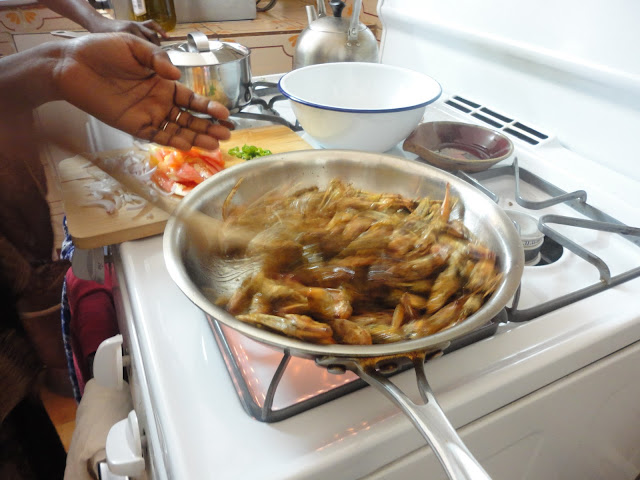"Before you cook them, you have
to remove the wings. Like this."
My two friends and I looked at each
other, eyebrows raised, before grabbing a grasshopper from the large pile on my
dining table. We gingerly pinched off the delicate wings as our
teacher, Aishatou, had shown us.
Grasshoppers are a popular snack food in
Niamey where you can buy them out of wheelbarrows on the outskirts of Katako
Marché. Though they are available year-round, the best time to eat the insect
is during the rainy season, when they
feast on green shoots breaking through the soil.
"Do you eat grasshoppers
often?" inquired one of my friends as we continued to de-wing our dinner.
"Oh all the time! But you, you
shouldn't eat too many. You're not used to them, so you might get a stomach
ache," replied our teacher.
I wondered to myself if "grasshopper
belly" couldn't be attributed to the use of insecticides. Each year, swarms of locusts (the migratory phase of grasshoppers) come down from Algeria and Libya in the North. Typically, the size of these swarms is kept in check by the use of pesticides. However, a representative from the Centre national de lutte antiacridienne (National Center for Locust Control) assured me that it is not these locusts that are gathered for consumption.
The grasshoppers for sale at Katako Marché are brought in almost year-round by villagers who sweep them up very early in the morning when the insects are too cold to move very much. At home, they boil the grasshoppers in a large cauldron full of salt-water. Afterwards, the insects are laid out to dry in the sun before being taken to market.
Once we had a neat pile of grasshopper
heads and thoraxes, we moved into the kitchen. Our teacher's recipe involved
sautéing the insects with onions, hot peppers, and spices until fragrant and
crispy.
"You'll know if the grasshoppers are
bad by the way they smell when you fry them," said Aishatou over the loud,
spluttery popping sounds coming from the pan. An earthy, piquant smell that
stung the inside of my nose filled the kitchen.
"So, do these smell like good
ones?" I asked.
"Oh, yes. You bought some very
nice ones. The eyes are clear and shiny, and they smell lovely, don't
they?"
"They smell like nothing I've
ever smelled before," I said laughing.
"Of course! But I'm sure you
are going to like these," said our teacher as she piled the well-cooked grasshoppers on a plate for us to share.
I have to admit that the final product looked pretty appetizing - as far as grasshoppers for dinner goes. Aishatou served the browned morsels with fresh tomatoes, onion, and a sprinkling of minced tonkoteo peppers.
Sitting around my dining table, my friends and I each took a warm grasshopper, silently wished each other luck, and popped them in our mouths. I braced myself for a crunchy, then squishy sensation based on a previous experience eating barbequed crickets at my grandmother's house. However, I was pleasantly surprised by how crispy and flavorful the grasshoppers were. It was a lot like eating spice-rubbed Pringles potato chips. They just sort of dissolved into feathery nothingness once you crunched through the brittle body.
Although I can't say that once I leave Niger I will have cravings for sautéed grasshoppers, I do know that if push comes to shove, I'll know how to turn those garden pests into something palatable!





